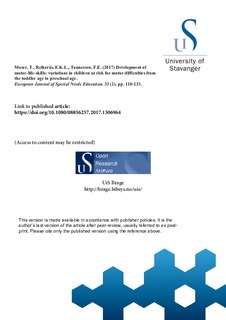| dc.contributor.author | Moser, Thomas | |
| dc.contributor.author | Reikerås, Elin Kirsti Lie | |
| dc.contributor.author | Tønnessen, Finn Egil | |
| dc.date.accessioned | 2018-01-23T12:54:25Z | |
| dc.date.available | 2018-01-23T12:54:25Z | |
| dc.date.created | 2017-04-24T12:30:34Z | |
| dc.date.issued | 2017-03 | |
| dc.identifier.citation | Moser, T., Reikerås, E.K.L., Tønnessen, F.E. (2017) Development of motor-life-skills: variations in children at risk for motor difficulties from the toddler age to preschool age. European Journal of Special Needs Education. 33 (1), pp. 118-133. | nb_NO |
| dc.identifier.issn | 0885-6257 | |
| dc.identifier.uri | http://hdl.handle.net/11250/2479095 | |
| dc.description | This is an Accepted Manuscript of an article published by Taylor & Francis in the European Journal of Special Needs Education on 31.03.2017, available online: http://www.tandfonline.com/10.1080/08856257.2017.1306964. | nb_NO |
| dc.description.abstract | This article explores variations in development of everyday motor-life-skills in 661 children (329 girls and 332 boys) in Norwegian kindergartens of ages 2:9 (T1) and 4:9 (T2) years:months. The particular focus is on children at risk for problems in motor development (the 10% weakest children in the sample). The methodological approach chosen is authentic assessment, applying the Early Years Movement Skills Checklist (EYMSC). All correlations between motor-life-skills at ages 2:9 and 4:9 are statistically significant (p < 0.01), varying between r = 0.26 to 0.38 for the four section scores of EYMSC (Self-help skills, Desk skills, General classroom skills and Recreational and playground skills) and r = 0.39 for the EYMSC total score. The group composition of children assumed to be at risk for motor difficulties changes considerably between ages 2:9 and 4:9. Approximately, two-thirds of the 10% weakest at T1 do not belong to the 10% weakest at T2. Logistic regression failed to identify children at risk at T1 being among the 10% weakest at T2. However, for two sections of EYMSC (Self-help skills; Recreational and Playground skills), it was possible to distinguish between stable and flux groups. | nb_NO |
| dc.language.iso | eng | nb_NO |
| dc.publisher | Taylor & Francis | nb_NO |
| dc.subject | utdanningsvitenskap | nb_NO |
| dc.subject | pedagogikk | nb_NO |
| dc.subject | motorikk | nb_NO |
| dc.subject | barnehage | nb_NO |
| dc.subject | førskole | nb_NO |
| dc.subject | motoriske ferdigheter | nb_NO |
| dc.title | Development of motor-life-skills: variations in children at risk for motor difficulties from the toddler age to preschool age | nb_NO |
| dc.type | Journal article | nb_NO |
| dc.type | Peer reviewed | nb_NO |
| dc.description.version | acceptedVersion | nb_NO |
| dc.rights.holder | © 2017 Informa UK Limited, trading as Taylor & Francis Group | nb_NO |
| dc.subject.nsi | VDP::Social science: 200::Education: 280 | nb_NO |
| dc.source.pagenumber | 118-133 | nb_NO |
| dc.source.volume | 33 | nb_NO |
| dc.source.journal | European Journal of Special Needs Education | nb_NO |
| dc.source.issue | 1 | nb_NO |
| dc.identifier.doi | 10.1080/08856257.2017.1306964 | |
| dc.identifier.cristin | 1466192 | |
| dc.relation.project | Universitetet i Stavanger: Stavanger kommune; UiS lesesenteret | nb_NO |
| cristin.unitcode | 217,6,6,0 | |
| cristin.unitcode | 217,6,3,0 | |
| cristin.unitname | Nasjonalt senter for leseopplæring og leseforsking | |
| cristin.unitname | Institutt for grunnskolelærerutdanning, idrett og spesialpedagogikk | |
| cristin.ispublished | true | |
| cristin.fulltext | postprint | |
| cristin.qualitycode | 2 | |
